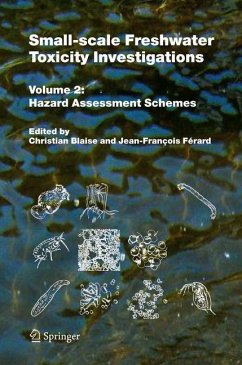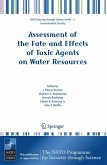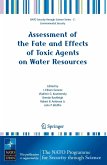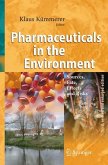Developed, developing and emerging economies worldwide are collectively contributing multiple stresses on aquatic ecosystems by the release of numerous contaminants. This in turn demands that basic toxicological information on their potential to harm living species be available. Hence, environmental protection programs aimed at preserving water quality must have access to comprehensive toxicity screening tools and strategies that can be applied reliably and universally. While a good number of toxicity testing procedures and hazard assessment approaches have been published in the scientific literature over the past decades, many are wanting in that insufficient detail is available for users to be able to fully understand the test method or scheme and to be able to reproduce it successfully. Even standardized techniques published in recognized international standard organization documents are often lacking in thoroughness and minutiae. Paucity of information relating to biological test methods may be consequent and trigger several phenomena including generation of invalid data and resulting toxicity measurements, erroneous interpretation and decision-taking with regards to a particular chemical or environmental issue, or simply abandonment of testing procedures. Clearly, improperly documented toxicity testing methods can be detrimental to their promotion and use, as they open the doorway to unnecessary debate and criticism as to their raison d'être. Furthermore, this situation can indirectly contribute to delaying, minimizing or eliminating their application, thereby curtailing the important role toxicity testing plays in the overall protection and conservation of aquatic ecosystems.
"The editors and contributors have done an excellent job of covering a wide and rapidly moving field of environmental science in a sound, exciting, and up-to-date way. On the one hand, these volumes are very suitable for well-experienced researchers and, on the other, for students, because they provide clear explanations of small-scale toxicity testing procedures and hazard assessments with special attention being given to freshwater investigations. Excellent, very useful!" -- Ivan Holoubek, Professor at Masaryk University Brno, CR and President of SECOTOX
"Environmental contamination is a worldwide problem, these volumes provide a detailed account of toxicity assessment using biotests for freshwater and sediment which will be of great value to students and practitioners alike." -- Ian Falconer, Editor Environmental Toxicology, University of Adelaide, Australia
"Both editors and contributors of these books have demonstrated outstanding talent in presenting a thorough review of toxicity testing applications and in detailing the theoretical and practical aspects of several small-scale procedures and hazard assessment schemes. These two companion volumes are an important contribution to the field of freshwater ecotoxicology. They will prove immensely useful for all professional scientists and students alike desirous of knowing and applying reliable tools and approaches to appraise the numerous adverse effects that anthropogenic sources of toxic pollutants can have on aquatic environments." -- François Ramade, Emeritus Professor of Ecology, University of Paris-Sud, France
"Blaise and Ferard have provided a comprehensive account of biotests for environmental toxicity and their use in hazard assessment of contamination which will be of great value to those concerned with the worldwide problem of environmental degradation". Ian Falconer, Editor Environmental Toxicology University of Adelaide, Australia.
"Both editors and the contributors of this book have demonstrated that they are able to provide comprehensive information on biological testing as well regarding theory and concepts as regarding toxicity testing applications. For academia, governmental authorities and consulting people the two volumes are of interest and helpful. One can state that these two volumes are 'state of the art' and are an important contribution to the field of freshwater ecotoxicology". Prof..Dr. rer.nat. Dr. h.c. A. Kettrup, Technische Universität München
"Environmental contamination is a world-wide problem, which is of increasing concern with the rapid industrialization of nations which are moving out of the less-developed nation status. Many industrial products formerly made in highly developed nations, are now being made offshore and imported, leaving the environmental impacts of their production to nations with less sophisticated procedures for environmental monitoring. The advantage of small-scale biotests for toxicity assessment is the simplicity of equipment requirements and the lesser need for advanced technical training to carry out the tests. This approach to pollution monitoring is therefore highly relevant to the emerging industrialized nations. Biotests however continue to remain relevant to highly developed nations, due to the complex mixtures of pollutants generated by industrial processes, which are not totally amenable to assessment by analytical chemistry.
Volume 1 describes, in sufficient detail for the methodology to be followed in an environmental pollution laboratory, use of bacteria, algae, macrophytes, protozoa, small invertebrates and fish cells in toxicity testing. The volumes both commence with an overview of the application of small scale biotests to effluents, with extensive referencing. It is of interest to note that the most-used toxicity tests employ small invertebrates such as Daphnia species which can be obtained from wild populations, thus reducing the costs of tests. One of the points made in this volume is the different responses of organisms at different trophic levels to pollutants, necessitating use of a range of organisms in testing of any pollutant.
Volume 2 demonstrates the integration of a battery of toxicity tests in the hazard assessment of pollutants. One of the issues that arises from the differential sensitivity of organisms to pollutants is the approach to be used when applying disparate results in a composite hazard assessment. In this volume several different approaches are described, aimed at providing an overall toxicity measure that is intelligible to regulators. Methodologies developed in Canada, France, Germany and South America are described, using different approaches. The volume concludes with methodologies for toxicity assessment in solid wastes and sediments.
Both volumes will be of practical use to practitioners in pollution monitoring and hazard assessment, and can be recommended." Ian Falconer, Editor Environmental Toxicology University of Adelaide, Australia.
"Environmental contamination is a worldwide problem, these volumes provide a detailed account of toxicity assessment using biotests for freshwater and sediment which will be of great value to students and practitioners alike." -- Ian Falconer, Editor Environmental Toxicology, University of Adelaide, Australia
"Both editors and contributors of these books have demonstrated outstanding talent in presenting a thorough review of toxicity testing applications and in detailing the theoretical and practical aspects of several small-scale procedures and hazard assessment schemes. These two companion volumes are an important contribution to the field of freshwater ecotoxicology. They will prove immensely useful for all professional scientists and students alike desirous of knowing and applying reliable tools and approaches to appraise the numerous adverse effects that anthropogenic sources of toxic pollutants can have on aquatic environments." -- François Ramade, Emeritus Professor of Ecology, University of Paris-Sud, France
"Blaise and Ferard have provided a comprehensive account of biotests for environmental toxicity and their use in hazard assessment of contamination which will be of great value to those concerned with the worldwide problem of environmental degradation". Ian Falconer, Editor Environmental Toxicology University of Adelaide, Australia.
"Both editors and the contributors of this book have demonstrated that they are able to provide comprehensive information on biological testing as well regarding theory and concepts as regarding toxicity testing applications. For academia, governmental authorities and consulting people the two volumes are of interest and helpful. One can state that these two volumes are 'state of the art' and are an important contribution to the field of freshwater ecotoxicology". Prof..Dr. rer.nat. Dr. h.c. A. Kettrup, Technische Universität München
"Environmental contamination is a world-wide problem, which is of increasing concern with the rapid industrialization of nations which are moving out of the less-developed nation status. Many industrial products formerly made in highly developed nations, are now being made offshore and imported, leaving the environmental impacts of their production to nations with less sophisticated procedures for environmental monitoring. The advantage of small-scale biotests for toxicity assessment is the simplicity of equipment requirements and the lesser need for advanced technical training to carry out the tests. This approach to pollution monitoring is therefore highly relevant to the emerging industrialized nations. Biotests however continue to remain relevant to highly developed nations, due to the complex mixtures of pollutants generated by industrial processes, which are not totally amenable to assessment by analytical chemistry.
Volume 1 describes, in sufficient detail for the methodology to be followed in an environmental pollution laboratory, use of bacteria, algae, macrophytes, protozoa, small invertebrates and fish cells in toxicity testing. The volumes both commence with an overview of the application of small scale biotests to effluents, with extensive referencing. It is of interest to note that the most-used toxicity tests employ small invertebrates such as Daphnia species which can be obtained from wild populations, thus reducing the costs of tests. One of the points made in this volume is the different responses of organisms at different trophic levels to pollutants, necessitating use of a range of organisms in testing of any pollutant.
Volume 2 demonstrates the integration of a battery of toxicity tests in the hazard assessment of pollutants. One of the issues that arises from the differential sensitivity of organisms to pollutants is the approach to be used when applying disparate results in a composite hazard assessment. In this volume several different approaches are described, aimed at providing an overall toxicity measure that is intelligible to regulators. Methodologies developed in Canada, France, Germany and South America are described, using different approaches. The volume concludes with methodologies for toxicity assessment in solid wastes and sediments.
Both volumes will be of practical use to practitioners in pollution monitoring and hazard assessment, and can be recommended." Ian Falconer, Editor Environmental Toxicology University of Adelaide, Australia.
"The editors and contributors have done an excellent job of covering a wide and rapidly moving field of environmental science in a sound, exciting, and up-to-date way. On the one hand, these volumes are very suitable for well-experienced researchers and, on the other, for students, because they provide clear explanations of small-scale toxicity testing procedures and hazard assessments with special attention being given to freshwater investigations. Excellent, very useful!"
Ivan Holoubek, Professor at Masaryk University Brno, CR and President of SECOTOX
"Environmental contamination is a worldwide problem, these volumes provide a detailed account of toxicity assessment using biotests for freshwater and sediment which will be of great value to students and practitioners alike."
Ian Falconer, Editor Environmental Toxicology, University of Adelaide, Australia
"Both editors and contributors of these books have demonstrated outstanding talent in presenting a thorough review of toxicity testing applications and in detailing the theoretical and practical aspects of several small-scale procedures and hazard assessment schemes. These two companion volumes are an important contribution to the field of freshwater ecotoxicology. They will prove immensely useful for all professional scientists and students alike desirous of knowing and applying reliable tools and approaches to appraise the numerous adverse effects that anthropogenic sources of toxic pollutants can have on aquatic environments."
François Ramade, Emeritus Professor of Ecology, University of Paris-Sud, France
"Blaise and Ferard have provided a comprehensive account of biotests for environmental toxicity and their use in hazard assessment of contamination which will be of great value to those concerned with the worldwide problem of environmentaldegradation". Ian Falconer, Editor Environmental Toxicology University of Adelaide, Australia.
"Both editors and the contributors of this book have demonstrated that they are able to provide comprehensive information on biological testing as well regarding theory and concepts as regarding toxicity testing applications. For academia, governmental authorities and consulting people the two volumes are of interest and helpful. One can state that these two volumes are "state of the art" and are an important contribution to the field of freshwater ecotoxicology". Prof..Dr. rer.nat. Dr. h.c. A. Kettrup, Technische Universität München
Environmental contamination is a world-wide problem, which is of increasing concern with the rapid industrialization of nations which are moving out of the less-developed nation status. Many industrial products formerly made in highly developed nations, are now being made offshore and imported, leaving the environmental impacts of their production to nations with less sophisticated procedures for environmental monitoring. The advantage of small-scale biotests for toxicity assessment is the simplicity of equipment requirements and the lesser need for advanced technical training to carry out the tests. This approach to pollution monitoring is therefore highly relevant to the emerging industrialized nations. Biotests however continue to remain relevant to highly developed nations, due to the complex mixtures of pollutants generated by industrial processes, which are not totally amenable to assessment by analytical chemistry.
Volume 1 describes, in sufficient detail for the methodology to be followed in an environmental pollution laboratory, use of bacteria, algae, macrophytes, protozoa, small invertebrates and fish cells in toxicity testing. The volumes both commence with an overview of the application of small scale biotests to effluents, with extensivereferencing. It is of interest to note that the most-used toxicity tests employ small invertebrates such as Daphnia species which can be obtained from wild populations, thus reducing the costs of tests. One of the points made in this volume is the different responses of organisms at different trophic levels to pollutants, necessitating use of a range of organisms in testing of any pollutant.
Volume 2 demonstrates the integration of a battery of toxicity tests in the hazard assessment of pollutants. One of the issues that arises from the differential sensitivity of organisms to pollutants is the approach to be used when applying disparate results in a composite hazard assessment. In this volume several different approaches are described, aimed at providing an overall toxicity measure that is intelligible to regulators. Methodologies developed in Canada, France, Germany and South America are described, using different approaches. The volume concludes with methodologies for toxicity assessment in solid wastes and sediments.
Both volumes will be of practical use to practitioners in pollution monitoring and hazard assessment, and can be recommended. Ian Falconer, Editor Environmental Toxicology University of Adelaide, Australia.
Ivan Holoubek, Professor at Masaryk University Brno, CR and President of SECOTOX
"Environmental contamination is a worldwide problem, these volumes provide a detailed account of toxicity assessment using biotests for freshwater and sediment which will be of great value to students and practitioners alike."
Ian Falconer, Editor Environmental Toxicology, University of Adelaide, Australia
"Both editors and contributors of these books have demonstrated outstanding talent in presenting a thorough review of toxicity testing applications and in detailing the theoretical and practical aspects of several small-scale procedures and hazard assessment schemes. These two companion volumes are an important contribution to the field of freshwater ecotoxicology. They will prove immensely useful for all professional scientists and students alike desirous of knowing and applying reliable tools and approaches to appraise the numerous adverse effects that anthropogenic sources of toxic pollutants can have on aquatic environments."
François Ramade, Emeritus Professor of Ecology, University of Paris-Sud, France
"Blaise and Ferard have provided a comprehensive account of biotests for environmental toxicity and their use in hazard assessment of contamination which will be of great value to those concerned with the worldwide problem of environmentaldegradation". Ian Falconer, Editor Environmental Toxicology University of Adelaide, Australia.
"Both editors and the contributors of this book have demonstrated that they are able to provide comprehensive information on biological testing as well regarding theory and concepts as regarding toxicity testing applications. For academia, governmental authorities and consulting people the two volumes are of interest and helpful. One can state that these two volumes are "state of the art" and are an important contribution to the field of freshwater ecotoxicology". Prof..Dr. rer.nat. Dr. h.c. A. Kettrup, Technische Universität München
Environmental contamination is a world-wide problem, which is of increasing concern with the rapid industrialization of nations which are moving out of the less-developed nation status. Many industrial products formerly made in highly developed nations, are now being made offshore and imported, leaving the environmental impacts of their production to nations with less sophisticated procedures for environmental monitoring. The advantage of small-scale biotests for toxicity assessment is the simplicity of equipment requirements and the lesser need for advanced technical training to carry out the tests. This approach to pollution monitoring is therefore highly relevant to the emerging industrialized nations. Biotests however continue to remain relevant to highly developed nations, due to the complex mixtures of pollutants generated by industrial processes, which are not totally amenable to assessment by analytical chemistry.
Volume 1 describes, in sufficient detail for the methodology to be followed in an environmental pollution laboratory, use of bacteria, algae, macrophytes, protozoa, small invertebrates and fish cells in toxicity testing. The volumes both commence with an overview of the application of small scale biotests to effluents, with extensivereferencing. It is of interest to note that the most-used toxicity tests employ small invertebrates such as Daphnia species which can be obtained from wild populations, thus reducing the costs of tests. One of the points made in this volume is the different responses of organisms at different trophic levels to pollutants, necessitating use of a range of organisms in testing of any pollutant.
Volume 2 demonstrates the integration of a battery of toxicity tests in the hazard assessment of pollutants. One of the issues that arises from the differential sensitivity of organisms to pollutants is the approach to be used when applying disparate results in a composite hazard assessment. In this volume several different approaches are described, aimed at providing an overall toxicity measure that is intelligible to regulators. Methodologies developed in Canada, France, Germany and South America are described, using different approaches. The volume concludes with methodologies for toxicity assessment in solid wastes and sediments.
Both volumes will be of practical use to practitioners in pollution monitoring and hazard assessment, and can be recommended. Ian Falconer, Editor Environmental Toxicology University of Adelaide, Australia.








